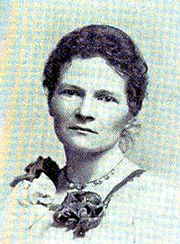
Margaret Todd (doctor)
Encyclopedia

Scotland
Scotland is a country that is part of the United Kingdom. Occupying the northern third of the island of Great Britain, it shares a border with England to the south and is bounded by the North Sea to the east, the Atlantic Ocean to the north and west, and the North Channel and Irish Sea to the...
writer and doctor who in 1913 suggested the term "isotope
Isotope
Isotopes are variants of atoms of a particular chemical element, which have differing numbers of neutrons. Atoms of a particular element by definition must contain the same number of protons but may have a distinct number of neutrons which differs from atom to atom, without changing the designation...
" to chemist Frederick Soddy
Frederick Soddy
Frederick Soddy was an English radiochemist who explained, with Ernest Rutherford, that radioactivity is due to the transmutation of elements, now known to involve nuclear reactions. He also proved the existence of isotopes of certain radioactive elements...
.
Career
A GlaswegianGlasgow
Glasgow is the largest city in Scotland and third most populous in the United Kingdom. The city is situated on the River Clyde in the country's west central lowlands...
schoolteacher, in 1886 Todd became one of the first students at the Edinburgh School of Medicine for Women
Edinburgh School of Medicine for Women
The Edinburgh School of Medicine for Women was founded by Dr Sophia Jex-Blake in Edinburgh, Scotland, in 1886, with support from the National Association for Promoting the Medical Education of Women....
after hearing that the Scottish Royal College of Physicians and Surgeons had opened their exams to women. She took eight years to complete the four-year course because, using the pseudonym Graham Travers, during her studies she wrote a novel, Mona Maclean, Medical Student.
This was described by Punch
Punch (magazine)
Punch, or the London Charivari was a British weekly magazine of humour and satire established in 1841 by Henry Mayhew and engraver Ebenezer Landells. Historically, it was most influential in the 1840s and 50s, when it helped to coin the term "cartoon" in its modern sense as a humorous illustration...
magazine as "a novel with a purpose — no recommendation for a novel, more especially when the purpose selected is that of demonstrating the indispensability of women-doctors". After graduating in 1894 she took her MD in Brussels and was appointed Assistant Medical Officer at Edinburgh Hospital and Dispensary for Women and Children but retired after five years.
Her first book having been exceptionally well received and into further editions, she published Fellow Travellers and Kirsty O’ The Mill Toun in 1896, followed by Windyhaugh in 1898, always using her male pen name, although by 1896 reviewers were calling her "Miss Travers". By 1913 even her publishers added "Margaret Todd, M.D." in parentheses after her pseudonym. In addition to six novels she wrote short stories for magazines.
Personal life
Despite their nineteen-year age difference, Todd was the romantic partner of Dr Sophia Jex-BlakeSophia Jex-Blake
Sophia Louisa Jex-Blake was an English physician, teacher and feminist. She was one of the first female doctors in the United Kingdom of Great Britain and Ireland, a leading campaigner for medical education for women and was involved in founding two medical schools for women, in London and in...
, founder of Dr Todd's university and place of employment. Upon Jex-Blake's retirement in 1899, they moved to Windydene, Mark Cross, where Dr Todd wrote The Way of Escape in 1902 and Growth in 1906. After Dr Jex-Blake died she wrote, under her own name, The Life of Dr Sophia Jex-Blake, a book described as ‘almost too laboriously minute for the general reader’.
Death
She died at the age of fifty-eight, just three months after the book was published in 1918.According to one source, she committed suicide; her Times obituary states only that she died in a nursing home in London. After her death a scholarship was created in her name at the LSMW.
Other
In 1913 she had suggested the word ‘isotope’ to her distant relation Frederick SoddyFrederick Soddy
Frederick Soddy was an English radiochemist who explained, with Ernest Rutherford, that radioactivity is due to the transmutation of elements, now known to involve nuclear reactions. He also proved the existence of isotopes of certain radioactive elements...
. Greek for ‘at the same place’, it suited perfectly and using it he went on to win the Nobel Prize for Chemistry in 1921.
Selected writings
(1894)- Fellow Travellers (1896)
- Kirsty O’ The Mill Toun (1896)
(1899)
- The Way of Escape (1902)
- Growth (1906)
- The Life of Sophia Jex-Blake (1918)

